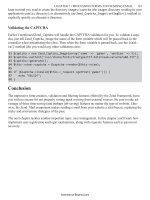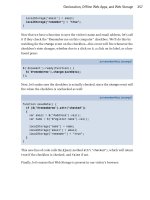Ozren Ocic Oil Refineries in the 21st CenturyOil phần 5 doc
Bạn đang xem bản rút gọn của tài liệu. Xem và tải ngay bản đầy đủ của tài liệu tại đây (226.11 KB, 15 trang )
For the purpose of this process block, the energy-flow scheme is shown in Scheme 4,
and Senky’s diagram for the energy balance in Diagram 3. The values given for the
energy consumption refer to the annual scope of processing being 973 085 t of vacuum
residue and for a specific slate of products.
Scheme 4 Energy flows of vacuum-residue visbreaking process
Diagram 3 Senky’s diagram of energy flows of vacuum-residue visbreaking process, in TJ/y
4 Instruments for Determining Energy and Processing Efficiency of an Oil Refinery52
The difference between gross and net power consumption appears in the case of MP
and LP steam due to internal steam generation in the plant. Internal MP steam ge-
neration of 135 000 t or 404 TJ meets the process requirements. Part of the steam, i.e.
115 000 t or 344 TJ, is used for the pump drive through steam turbines and the other
part of 20 000 t or 60 TJ for other process purposes.
4.3.3
Determining the Steam Cost Price
The procedure for determining the cost price of steam, as a possible instrument for
monitoring the energy efficiency needed by operative management, is given in Tables
18 and 19.
From Tab. 18, it can be seen that the cost price of MP steam generated in the va-
cuum-residue visbreaking unit is only 0.22 US$/t. The basic explanation for such a
cost lies in the fact that on this particular plant, the steam is obtained as a by-product,
utilizing the heat of the flue gases in the boiler and the heat of the products in the heat
exchangers, thus offsetting the consumption of engine fuel (fuel oil or fuel gas) and it
is well known that in the calculation of the power-plant-produced steam, engine fuel
bears the largest portion, its share in the total production cost structure being approxi-
mately 80 %. Other elements used for this calculation (besides energy fuel) that are
dictating the cost of 0.22 US$/t are the following: demineralised water (0.165
US$/t), depreciation cost of three heat exchangers and one vessel/boiler determined
on the basis of the equipment value of 54 040 US$ and a depreciation rate of 12.5%,
the cost of current and investment maintenance and the insurance premium for the
above-mentioned equipment covered under “other”. Internal LP steam generated in
the heat exchangers amounts to 27 000 t or 75 TJ and the steam obtained as a result of
Tab. 18 Cost price of medium-pressure steam (generation-con-
sumption)
Item
no.
Elements for
calculation
Annual
q’ty in t
Price
US$/t
MpS
generation
in US$
MpS consumption (US$)
Pump drive
through steam
turbines
For other
process
requirements
12 3 4 5 6 7
(%) from quantity 1.00000000 85.185185 14.814815
1 Demin water 135 000 0.165 22 275 18 975 3 300
2 Depreciation 6 755 5 754 1 001
3 Other 170 145 25
4 Cost price (1 - 3) 29 200 24 874 4 326
5 Quantity in t/y 135 000 115 000 20 000
6 Cost price in US$/t 0.2163 0.2163 0.2163
4.3 Instruments for Determining Energy and Processing Efficiency of Vacuum-residue Visbreaking Unit 5353
the reduction on the back-pressure turbines to 115 000 t or 320 TJ. Such a production
level meets this process requirement of 30 000t or 83 TJ, while the difference is used to
meet the demands of the process/consumers other than the vacuum-residue visbreak-
ing process. The cost of LP steam obtained through MP steam reduction on back-
pressure turbines is 0.22 US$/t and that of the steam produced in heat exchangers
is 0.29 US$/t. The average cost of LP steam obtained by the above two methods is
0.23 US$/t and/or 0.05 US$/t after the value of the LP steam supplied to other con-
sumers has been deducted (see Tab. 19).
It is apparent that the cost of the LP steam produced in heat exchangers (0.29 US$/t)
is higher than that of the Lp steam obtained through MP steam reduction. Such be-
haviour of the cost of LP steam obtained by means of reduction and in heat exchangers
is determined by the steam-production level and fixed costs (depreciation, current and
investment maintenance and capital assets insurance premium) that, viewed per unit
of product, decrease as the production level increases and vice versa, increase as the
production level decreases. The LP steam cost of 0.05 US$/t is also noticed to be ex-
tremely low. In this analysis visbreaking is treated as an independent entity that uses
30 000 t of this steam for its internal purposes and sells all other available quantities
(112 000 t) to other consumers at cost price, thus offsetting a part of the costs (25 779
US$/t) that further lowers the cost of the LP steam produced.
Tab. 19 Cost price of low-pressure steam (LpS)
Item
no.
Elements
for calculation
Annual
q’ty in t
Price
US$/t
LpS
generation
in US$
LpS consumption (US$)
for
process
for other
consumers
12 3 4 5 6 7
(%) from quantity 100.00000 21.126760 78.873240
LP steam reduction
MP steam 115 000 0.22 24 874
1 LP steam through
MP steam reduction 115 000 0.22 24 874 5 255 19 619
LP steam generation
2 Demin water 27 000 0.165 4 455 941 3 514
3 Heat-exchanger depreciation 3 273 692 2 581
4 Other 82 17 65
5 Cost price (2-4) 27 000 0.29 7 810 1 650 6 160
6 Total (1+5) 142 000 0.23 32 684 6 905 25 779
7 Quantity in t/y 142 000 30 000 112 000
8 Cost price in US$/t 0.23 0.23 0.23
9 Cost price after delivery to other consumers in US$/t0.05
4 Instruments for Determining Energy and Processing Efficiency of an Oil Refinery54
4.3.4
Energy Efficiency of the Process
The target standard of net energy consumption and specific gross and net energy
consumption on a typical vacuum-residue visbreaking unit is outlined in Tab. 20, and
Tab. 21 gives a financial presentation of energy consumption and money savings that
can be achieved by eliminating the differences between the target standard and spe-
cific gross and net energy consumption of this refinery unit.
As already explained, the excess of LP steam produced in this process is given to
other processes within the refinery; this fact is taken into consideration for the calcu-
lation of specific net energy consumption. Specific net consumption of process and
thermal energy is obtained when the energy value of the steam delivered is deducted
from the energy value of the fuel consumed, i.e.:
½ð1 380 þ 183ÞÀ312TJ
970 085 t of feedstock
¼ 1285:6
MJ
t of feedstock
If specific net energy consumption of a typical plant is compared with the target
standard the following conclusion can be drawn:
1. Specific electric energy consumption is close to the target standard;
2. Specific net consumption of process and thermal energy on a typical plant
amounts to 1285.6 MJ/t, thus exceeding the target standard (1164 MJ/t) by 11 %,
3.
Total specific net energy consumption is 1325.2 MJ/t, which is 10 % higher than the
target standard (1200 MJ/t). This means that, compared with the net energy con-
sumption target standard, a typical plant has an efficiency/inefficiency index of 110.
Tab. 20 Target standard of net energy consumption and specific
energy consumption on a typical vacuum-residue visbreaking unit
(quantity of energy per one tonne of feedstock)
Energy carriers Target standard
of net energy
consumption
Specific energy consumption in the plant
Specific gross energy
consumption
Specific net energy
consumption
(kg/t)
1
(kWh/t)
(MJ/t) (kg/t)
1
(kWh/t)
(MJ/t)
(MJ/t) (kWh/t)
per unit total per unit total
Fuels 1 605.3 1 285.6
Fuel gas * – 24.8 1 417.7 * *
Fuel oil * – 4.7 187.6 * *
Heat carriers 500.9
LP steam * – 31 86.2
MP steam * – 138.7 414.7
Sources of heat 1 164 –––2106.2 – – 1 285.6
Electric energy 36 10.0 11.0
1
39.6 39.6 11.0
1
39.6 39.6
Energy carriers 1 200 –––2145.8 – – 1 325.2
4.3 Instruments for Determining Energy and Processing Efficiency of Vacuum-residue Visbreaking Unit 5555
This relatively small increase in energy consumption compared with the target stan-
dard is the result of internal production of large quantities of steam using the heat of
flue gases and process products. In addition to this, there are elements that could
further improve the energy efficiency of the plant such as:
– efficient preheating of combustion air using the heat of flue gases;
– economical combustion in the process heater (measuring the excess air), and
– energy integration of the plants (obtaining hotter vacuum residue from vacuum-
distillation process and visbreaking residue handing over its heat to the incoming
feedstock of another integrated process).
Tab. 21 Financial presentation of energy consumption and money
savings on a typical vacuum-residue visbreaking unit (in US$)
Specific gross energy consumption
Energy carriers Q’ty of
feedstock
US$
973 085 t
Fuel gas 973 085 t (1417.7 MJ/t  0.0027 US$/MJ) = 3 724 765
Fuel oil 973 085 t (187.6 MJ/t  0.00305 US$/MJ) = 556 780
Low-pressure steam 973 085 t (86.2 MJ/t  0.000018 US$/MJ) = 1 510
Medium-pressure
steam
973 085 t (414.7 MJ/t  0.000073 US$/MJ) = 29 459
Sources of heat 973 085 t (2 106.2 MJ/t  0.002105 US$/MJ) = 4 312 514
Electric energy 973 085 t (39.6 MJ/t  0.0167 US$/MJ) = 643 521
Energy carriers 973 085 t (2 145.8 MJ/t  0.002375 US$/MJ) = 4 956 035
Specific net energy consumption
US$/t
Fuel gas (1 135.3 MJ/t  0.0027 US$/MJ) = 3.0653
Medium-pressure steam (150.3 MJ/t  0.00305 US$/MJ) = 0.4584
Sources of heat (1 285.6 MJ/t  0.002741 US$/MJ) = 3.5237
Electric energy (39.6 MJ/t  0.0167 US$/MJ) = 0.6613
Energy carriers (1 325.2 MJ/t  0.003158 US$/MJ) = 4.1850
Sources of heat:
Internal net energy consumption (1 285.6 MJ/t  0.002741 US$/MJ) = 3.52
Target net energy consumption (1 164 MJ/t  0.002741 US$/MJ) = 3.19
Difference: 0.33
Energy carriers:
Internal net energy consumption (1 325.2 MJ/t  0.003158 US$/MJ) = 4.19
Target net energy consumption (1 200 MJ/t  0.003158 US$/MJ) = 3.79
Difference: 0.40
4 Instruments for Determining Energy and Processing Efficiency of an Oil Refinery56
4.3.5
Determining the Refinery Product Cost Prices
The purpose of this unit is to reduce the viscosity of fuel oil. Feedstock for the va-
cuum-residue visbreaking process is the vacuum residue obtained in the vacuum-dis-
tillation unit, and about 94% of the outlet is cracked residue, which presents the com-
ponent for fuel-oil blending.
The cost prices of semi-products generated on the vacuum-residue visbreaking unit,
are determined by equivalent numbers obtained by means of the density method, as
the best method, although equivalent numbers can be determined by the following
methods as well:
– thermal value method, and
– average production cost method.
By analysing the results obtained by using the different calculation bases for deter-
mining the equivalent numbers, in the vacuum-residue visbreaking unit, taking feed-
stock, which represents 92.27 % of the total costs, as an example, considerable differ-
ences in the cost prices of oil products generated on this unit can be seen. These
differences are presented in Tab. 22 and Graphics 9 and 10.
Besides the significant differences in cost prices for the same refinery product that
depend on the calculating bases for determining the equivalent numbers, (for exam-
ple, the cost price of cracked gasoline is from 126.35 US$/t – the base for determining
the equivalent numbers is product density, to 169.83 US$/t – the base for determining
the equivalent numbers is product thermal value), different ranges in oil-product cost
prices can be noted even with the same calculating base.
For example, when product density is the base for determining the equivalent num-
bers, the cost prices range from 70.96 US$/t (fuel oil) to 173.08 US$/t (cracked resi-
due).
The stated examples of the calculating bases’ effects on determining the equivalent
numbers do not present all the dilemmas that experts dealing with process-industry
Tab. 22 Cost prices of semi-products on vacuum-residue visbreaking
unit in US$/t (per calculating bases)
Item
no.
Semi-products Base for determining the equivalent number
for calculating the cost prices
Product Density
Method
Thermal Value
Method
Average Production
Cost Method
12 345
1 Fuel gas 70.96 169.83 169.83
2 Cracked gasoline 126.35 185.42 169.83
3 Cracked residue 173.08 171.86 169.83
4 Slop 169.83 171.81 169.83
4.3 Instruments for Determining Energy and Processing Efficiency of Vacuum-residue Visbreaking Unit 5757
calculations can face. The effects of the choice of reference derivatives, and the treat-
ment of the by-products are also important.
The effect of the choice of reference derivatives cracked residue (whose density is
0.999 g/cm
3
), cracked gasoline (whose density is 0.734 g/cm
3
) and fuel oil (whose den-
sity is 0.410 g/cm
3
) on determining the equivalent numbers, in the case of using the
same calculating base for determining the equivalent numbers (density method) are
shown in Tab. 23.
Graphic 9 Cost prices of semi-products on vacuum-residue
visbreaking unit, per products (in US$/t)
Graphic 10 Cost prices of semi-products on vacuum-residue
visbreaking unit, per calculating bases (in US$/t)
4 Instruments for Determining Energy and Processing Efficiency of an Oil Refinery58
It can be seen that the differences appearing in this case are smaller than those
appearing in the previous example of determining the equivalent numbers by diffe-
rent calculating bases (density, thermal value and quantity of products).
The results obtained by using the different reference derivatives, but the same cal-
culating base, i.e. density method, are shown in Tab. 23 and Graphics 11 and 12.
The cost prices of semi-products generated on the vacuum-residue visbreaking unit
were calculated in the following manner, using the product density method:
*
Proportional costs are distributed to semi-products generated in this unit according
to the percentages obtained from equivalent numbers by means of the density
method and reference product, i.e. cracked residue whose density is 0.999 g/
cm
3
(Tab. 24, Column 5 and Tab. 25, Line 2).
*
Fixed costs are distributed to semi-products according to the percentages obtained
from the quantity (Tab. 25, Line 3).
*
The price of slop is expressed on the level of feedstock average price.
Tab. 23 Cost prices of semi-products on vacuum-residue visbreaking
unit in US$/t (per reference products)
Item
no.
Semi-products Reference products
Cracked
residue
Cracked
gasoline
Fuel
gas
12 3 4 5
1 Fuel gas 70.96 71.26 71.21
2 Cracked gasoline 126.35 127.25 127.47
3 Cracked residue 173.08 173.05 173.05
4 Slop 169.83 169.83 169.83
Graphic 11 Cost prices of semi-products on vacuum-residue visbreaking unit,
per different reference products (in US$/t)
4.3 Instruments for Determining Energy and Processing Efficiency of Vacuum-residue Visbreaking Unit 5959
By using the mentioned methodology for distributing the proportional and fixed
costs of this unit to the bearers of costs, i.e. to the products obtained in this unit,
the following cost prices of semi-products are established:
Semi-products Cost prices in US$/t
12
Fuel gas 81.29
Cracked gasoline 139.00
Cracked residue 187.80
Slop 169.83
4.4
Instruments for Determining Energy and Processing Efficiency of Bitumen Blowing Unit
4.4.1
Technological Characteristics of the Process
The bitumen blowing feedstock is vacuum residue from the vacuum-distillation
unit. The vacuum residue has to be of an appropriate quality and limited paraffinic
content.
The bitumen blowing process consists of continuous oxidation of vacuum residue in
the reactor, at a temperature of 250–270
o
C. Oxidation is carried out by introducing the
air via a compressor, under pressure and at the temperature of 60
o
C. By blowing the air
over the heated feedstock, the oxygen from air causes oxidation of highly volatile sub-
stances. Feedstock oxidation is followed by reaction-heat separation. For providing
heat duty in the reactor, the possibility of leading the part of cooled bitumen into
reactor (reflux) is taken into consideration.
Graphic 12 Cost prices of semi-products on vacuum-residue
visbreaking unit, per same reference products (in US $/t)
4 Instruments for Determining Energy and Processing Efficiency of an Oil Refinery60
Tab. 2 4 Determining the equivalent numbers for distributing the proportional costs on vacuum-residue visbreaking unit
Item
no.
Oil products Quantity
in tons
Q’ty from
1 tonne
Density
g/cm
3
Equivalent
numbers
Condition
units
Cost of
1 condition
unit
Cost price
in US$/t
Cost of
feedstock
in US$
(%) for
proportional
costs
Cost of feed-
stock in US$
(entry-exit)
12 34567(4Â 6) 8 9(6 Â 8) 10(3 Â 9) 11 12
1 Fuel gas 14 708.3 21.51 0.410 0.41 8.82 173.082 70.96 1 043 757 0.008987606 1 043 760
2 Cracked gasoline 15 452.0 22.60 0.734 0.73 16.50 173.082 126.35 1 952 359 0.016811420 1 952 364
3 Cracked residue 653 660.0 955.89 0.999 1.00 955.89 173.082 173.08 113 136 788 0.974200974 113 137 093
4 Slop 12 460.8 – – – 0.00 169.83 2 116 221 – 2 116 221
5 Total
696 281.2 1 000.00 981.21
683 820.4
118 249 125 118 249 438
–2 116 221 –2 116 221
116 132 904 1.000000000 116 133 217
6 Loss 0.0
7 Total 696 281.2
The costs of one conditional unit are as follows:
Feedstock 118 249 438 US$ : 696 281 t = 169.83 US$/t
Feedstock 169.03 : 981.21 = 0.173082 i.e. 173.082 US$/t
4.4 Instruments for Determining Energy and Processing Efficiency of Bitumen Blowing Unit 6161
Tab. 25 Determining the cost prices of refinery products on vacuum-residue visbreaking unit
Item
no.
Elements for
calculation
Q’ty
in
tonness
Total
in US$
Cost
price
US$/t
Fuel gas Cracked
gasoline
Cracked
residue
Slop
12 3 4 5 6 7 8 9
1 Q’ty in tons 696 281 14 708.3 15 452.0 653 660.0 12 460.8
2 (%) from equivalent numbers 0.00898761 0.01681142 0.97420097
3 (%) from q’ty 0.02150906 0.02259659 0.95589435
4 Vacuum residue
696 281 118 249 438 169.83
5 Feedstock 696 281 118 249 438 169.83 1 043 760 1 952 364 113 137 093 2 116 221
6 Chemicals
7 Water 859 8 14 837
8 Steam 2 304 116 20 708 38 735 2 244 672
9 Electric power 606 549 5 451 10 197 590 901
10 Fuel 1 968 308 17 690 33 090 1 917 527
11 Depreciation 262 778 5 652 5 938 251 188
12 Other production costs 677 780 14 578 15 316 647 886
13 Wages 1 608 187 34 591 36 340 1 537 257
14 Taxes 707 402 15 216 15 985 676 202
15 Unit management costs 1 228 602 26 426 27 762 1 174 414
16 Laboratory and maintenance costs 269 139 5 789 6 082 257 269
17 Common services costs 266 980 5 742 6 033 255 205
18 Total costs 128 150 139 1 195 612 2 147 856 122 690 451 2 116 221
19 Cost price in US$/t 184.05 81.29 139.00 187.70 169.83
4 Instruments for Determining Energy and Processing Efficiency of an Oil Refinery62
Steam is introduced into the reactor top, so that reaction control is possible.
From the reactor, the finished bitumen is directed via the cooler into storage. Steam,
gases and other products formed by oxidation off the reactor top, are routed through
the separator to be burned in the process heater.
All the above mentioned technological characteristics are shown in Fig. 8.
4.4.2
Energy Characteristics of the Process
On a typical bitumen blowing unit, the vacuum residue that is introduced from the
vacuum-distillation unit at 130–150
o
C, is heated again in the process heater and di-
rected to the reactor. Fuel gas is used in the process heater as well as in the heater for
burning of gases.
Medium-pressure steam (MpS) is used for the pump drive, for the heating of tanks
and pipes, for monitoring the bitumen blowing reaction in the reactor, as well as for
the heating of compressed air.
Electric energy is used to drive pumps, fans and other auxiliary equipment.
The main energy characteristics of the bitumen blowing unit are shown in Fig. 9,
which also presents all the important alternatives in meeting the energy demands of
the process.
The block energy-flow scheme of this process is shown in Scheme 5 and Senky’s
diagram for the energy balance in Diagram 4. The values given for the energy
Fig. 8 Technological characteristics of bitumen blowing process
4.4 Instruments for Determining Energy and Processing Efficiency of Bitumen Blowing Unit 6363
Fig. 9 Energy characteristics of bitumen blowing process
Scheme 5 Energy flows of bitumen blowing process
consumption refer to the annual volume of production amounting to 94 314 t of feed-
stock.
The consumption of medium-pressure steam is 45 000 t or 135 TJ.
Internal low-pressure steam generation, obtained by reduction on back-pressure
turbines, is 18 000 t or 50 TJ and is used for other process requirements.
4 Instruments for Determining Energy and Processing Efficiency of an Oil Refinery64
4.4.3
Determining the Steam Cost Price
The cost prices of medium-pressure steam used in this unit, as well as the cost price of
low-pressure steam generated in this unit, by reduction of medium-pressure steam on
back-pressure turbines, and that is used for other process requirements, are given in
Tables 26 and 27.
The basic explanation for such a cost price of low-pressure steam lies in the fixed
costs (depreciation, current and investment maintenance and insurance premium of
equipment from the breakage and fire) related to the part of equipment that shares in
reduction of MP steam in LP steam.
This LP steam is delivered to other processes, i.e. it is not used on this unit.
Diagram 4 Senky’s diagram of energy flows of bitumen blowing
process, in TJ/y
Tab. 26 Cost price of medium-pressure steam (consumption)
Item
no.
Elements for
calculation
MpS consumption (US$)
Annual
q’ty in t
Cost price
US$/t
Total MpS
consumption
in US$
12 3 4 5
1 MP steam
(supply)
27 000 9.66 260 820
4.4 Instruments for Determining Energy and Processing Efficiency of Bitumen Blowing Unit 6565
4.4.4
Energy Efficiency of the Process
The target standard of net energy consumption and specific gross and net energy
consumption is outlined in Tab. 28, and a financial presentation of energy consump-
tion and money savings that can be achieved by eliminating the differences between
the target standard and specific gross and net energy consumption of this refinery unit
is presented in Tab. 29.
When calculating the specific net energy consumption, the energy value of gener-
ated LP steam, being supplied to other processes, is taken into consideration.
Tab. 27 Cost price of low-pressure steam (production-consumption)
Item
no.
Elements for calculation Low-pressure steam generation (LpS) LpS
consumption
for other
consumers
Annual
q’ty in t
Cost price
US$/t
Total in
US$
12 3 4 5 6
1 LP steam by reduction of MpS 18 000 9.66 173 880 173 880
2 Depreciation 3 397 3 397
3 Current and investment maintenance 407 407
4 Insurance premium for equipment 272 272
5 Total 18 000 9.89 177 956 177 956
6 Quantity in t 18 000 t 18 000 t
7 Cost price of LpS in US$/t 9.89 9.89
Tab. 28 Target standard of net energy consumption and specific
energy consumption on a typical bitumen blowing unit (quantity of
energy per one tonne of feedstock)
Energy carriers Target standard
of net energy
consumption
Specific energy consumption in the plant
Specific gross energy
consumption
Specific net energy
consumption
(kg/t)
1
(kWh/t)
(MJ/t) (kg/t)
1
(kWh/t)
(MJ/t)
(MJ/t) (kWh/t)
per unit total per unit total
Fuels
Fuel gas * – 13.6 677.6 677.6 13.6 677.6 677.6
Heat carriers
MP steam * – 480 1 435.2 1 435.2 * * 901.2
Sources of heat 1 257 –––2112.8 – – 1 578.8
Electric energy 43 12.0 13.3
1
47.9 47.9 13.3
1
47.9 47.9
Energy carriers 1 300 –––2160.7 – – 1 626.7
4 Instruments for Determining Energy and Processing Efficiency of an Oil Refinery66









